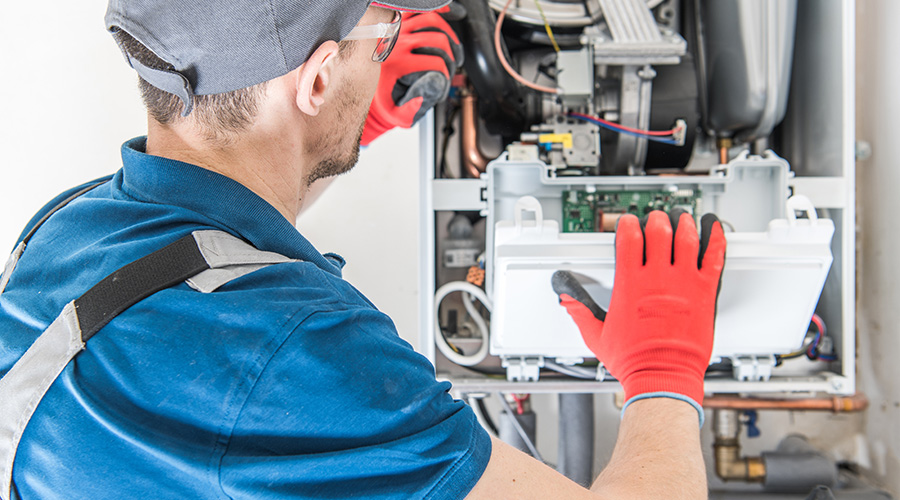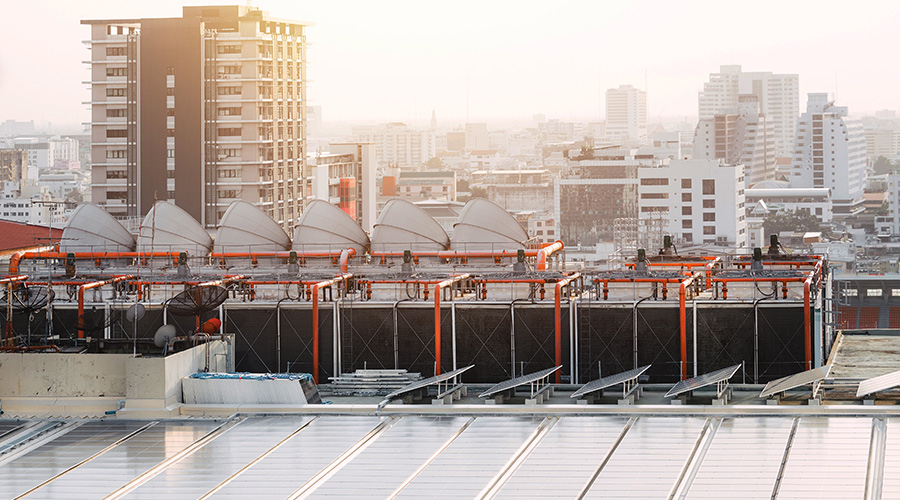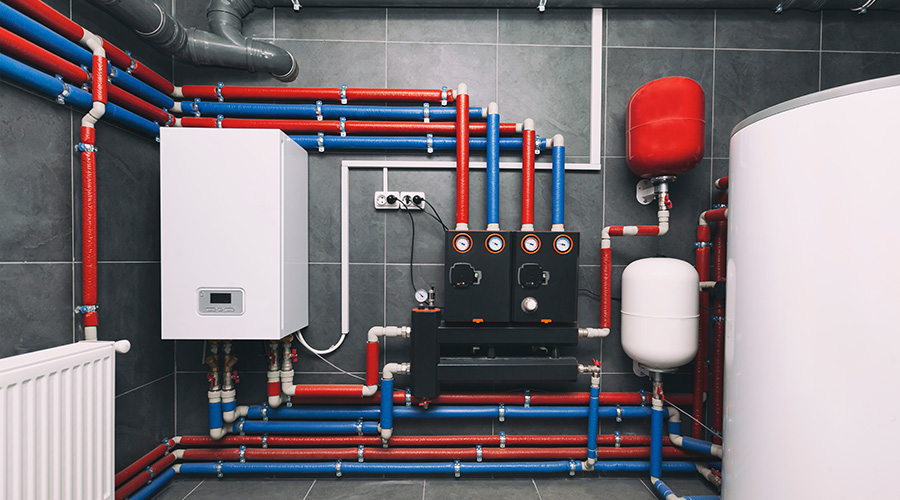Cooling in a Crunch
Suppliers offer strategies for making sound decisions in selecting on-demand cooling equipment
Maintenance and engineering managers can choose from a wide range of on-demand cooling equipment— from 1-ton portable units designed to cool small areas to several-thousand-ton, multi-unit systems that can cool entire buildings — to solve specific facility needs. In some cases, facilities might incorporate several types of equipment.
“If a building loses a 500-ton chiller, and that chiller is going to be down for a period of time, say 30-60 days, (managers) are probably going to make arrangements to bring in a temporary chiller,” says Garth Tagge, vice president of sales for Spot Coolers Inc. The equipment supplier and maintenance staff might need three or four days to set up the temporary chiller. In the meantime, a portable unit can serve areas of the building that need immediate cooling.
Because of the large variety of temporary cooling technologies, managers can help their organizations minimize problems by investigating cooling requirements and options before unexpected failures crop up.
Status Check
The key to averting a cooling crisis — or at least minimizing the damage — is preparation. Understanding their facilities’ cooling systems can help managers shorten response time if systems fail.
“One of the common mistakes that facilities make is not being prepared at all for cooling emergencies,” says Nick Sickmen, marketing manager for HVAC Portable Systems Inc. For example, when organizations add a chiller, they might not install disconnects or headers, which allow equipment installers to tie cooling equipment into the existing system.
“If you lose a chiller or a cooling tower and don’t have taps for us to tap into, there will be a delay because those taps have to be put in,” Sickmen says. Managers also can react better to cooling emergencies if they understand their facilities’ cooling needs.
“In the case of an emergency, they should at least know what load their air conditioner handles and the size of their unit,” says Kristy Mach, business communications manager for Temp-Air, adding that they should have a blueprint of the building’s HVAC systems available for emergency situations. “Whether it’s just one area that needs supplemental cooling or if it’s the whole building, a mechanical layout of the building, as well as its HVAC specifications, would help speed the process.”
Before equipment arrives, managers also can direct department workers to check areas in an around the facilities that the equipment might affect.
“There might be some things that need to be done at the job site, such as clearing out the parking lot,” Sickmen says. By taking care of these issues in advance, managers can speed up equipment installation and operation.
An Eye on Options
The next step in specifying temporary equipment is taking a close at all equipment options. Specifying cooling equipment, especially larger systems, is not like buying light bulbs or paper towels. It requires serious thought and thorough research.
“A lot of things can happen if you size it wrong,” Sickmen says, adding that undersizing a system can be just as problematic as oversizing it. In some cases, this mistake can result in lost revenue for tenants. In the case of universities, improperly sizing the equipment can jeopardize scientific experiments and put related grant funding at risk.
Specifiers “should treat (the process) as if they were buying a chiller to begin with,” he says. “They should put a lot of research into it to decide which HVAC system is best for them.” Mistakes also can occur with the smaller on-demand systems.
“A lot of people don’t realize a 5-ton portable air conditioner isn’t necessarily going to replace a 5-ton existing unit,” Tagge says. “There are design issues. An existing 5-ton air conditioner may be ducted through a system to distribute the air properly. If you bring in a 5-ton portable and stick it in the corner, it’s not going to distribute the air the same way as when it is ducted.”
In an emergency situation, managers might want to only provide on-demand cooling to only facilities’ most critical areas.
“I remember a project in a 12-story building where (the managers) were only concerned with floors five and six because that is where the computers were,” Sickmen says. In this case, they were most concerned about protecting the computer systems on these floors that tracked their billing and accounting records.
Also, managers can arrange for just enough cooling to keep the organization operating while the system is repaired.
“They don’t always need to match Btu for Btu,” Tagge says. “Typically, the engineer knows what equipment went down, and we provide some percentage of that capacity — maybe 75 percent — just to keep it running.”
A Supplier’s Role
Cooling-equipment suppliers can help managers determine the most appropriate on-demand cooling system.
“In the best scenario, we sit down with the facility’s engineers to determine their loads and calculate what they need and what they have,” Sickmen says. Detailed information is essential at this stage.
“When we receive a call, we go through a sequence of questions and get as much technical information as possible so when we show up, we don’t run into problems,” says Scott Brainard, product manager for Temp-Air.
For example, Brainard says, if a building’s third floor needs cooling and no window access is available, the equipment supplier might not be able to use a large industrial unit that sits outside because setting up temporary ductwork isn’t an option. Instead the supplier might have to use smaller portables that can fit into an elevator and set it up inside.
A range of other factors also affects a manager’s decision.
“Our 1-5-ton units fit in an elevator and are designed to fit through a standard-size door,” Tagge says, adding that units larger than 5 tons can present space challenges. Equipment suppliers can provide data on the size of the equipment.
Managers also should verify that electrical distribution systems could provide enough power to support the temporary systems. Even smaller portables require more than 110 volts of power.
“In a few cases, we’ve delivered equipment where they said they have all kinds of power to run it,” Brainard says, adding that, in fact, all the facilities have are 110-volt outlets.
“Once you get about 1.5 to 2 tons of cooling, which isn’t very much, you have to have high-voltage power to operate it,” he says. “Verify your power with your electrician before bring temporary equipment out to the site.” Managers can waste valuable time if an electrician needs to wire in additional power for emergency-cooling systems.
Larger pieces of equipment often equal larger installation challenges.
“Small, spot-cooling units are easy,” Brainard says. “We wheel them into a room, and all we have to do is duct the hot air out. With the bigger units that sit outside, we need the facility’s technicians to get involved.”
Before the supplier’s technicians leave the site after installation, technicians should carefully inspect the equipment and thoroughly understand its operating requirements.
Picking a Partner
Choosing the right vendor is just as critical as specifying the right equipment.
“You’re already in a situation where things have already gone bad,” Sickmen says. “You don’t want to make it worse by bringing someone in who really isn’t qualified to be doing this type of work.”
Managers who don’t take time to look for a qualified partner risk learning costly lessons, he says. Replacing a supplier that doesn’t have the necessary qualifications can waste critical time and money.
To ensure project satisfaction, managers can ask equipment suppliers several questions regarding equipment and qualifications. The first issue is finding out the condition and age of equipment they might rent.
“They should ask (suppliers) if they have new inventory or if it is all used,” Sickmen says. The level of maintenance suppliers give their equipment can be an indication of their attention to customer service.
“Ask vendors if they recondition all of their units every year,” Mach says, as well as when the equipment was last used. The longer the equipment has been sitting around unused and possibly neglected, the more likely it is that complications will arise.
Managers also can seek companies that sell only cooling systems. Those who also provide unrelated items, such as lift equipment or plumbing equipment, might lack the technical knowledge many portable and emergency cooling situations require.
Training and Service
Managers can smooth out the installation and operation process by asking the equipment supplier to describe their technicans’ training and certification.
“With today’s refrigerant laws, you don’t want service technicians who’ve never handled it,” Mach says. This issue also involves service response time because all equipment can break down. The goal here is to find vendors who provide around-the-clock service and short response times.
A facility’s maintenance department might be responsible for basic maintenance requirements, such as maintaining chemical treatment or changing filters, but the supplier should be responsible for any major equipment problems.
Before renting equipment, managers should find out if the vendor has its own technicians for repairs or if they rely on a third party.
“If they’re relying on someone else, you’re on their schedule and you might not be a high priority for them,” Sickmen says. Managers should look for vendors who have their own technicians and are prepared to take care of their own equipment no matter the time or day.
In emergency cooling situations, response time is critical. Managers need to know how fast their vendor’s service department is going to react if a piece of their equipment fails.
“Some people do it in a day or two and that isn’t really acceptable,” Brainard says. “It should really be in 2-4 hours.”
Related Topics:











